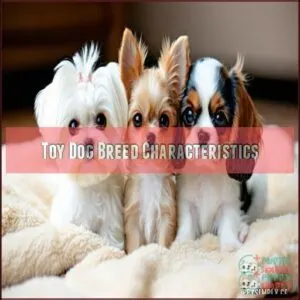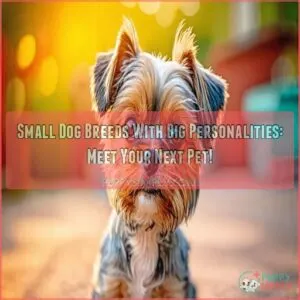This site is supported by our readers. We may earn a commission, at no cost to you, if you purchase through links.

The Pomeranian boasts a fluffy coat and bold attitude, while the Cavalier King Charles Spaniel charms with its gentle, people-loving nature.
Want low-maintenance grooming? The lively Chihuahua or playful Papillon might suit you better.
Shih Tzus and Maltese are great choices too, offering cuddly companionship and sweet dispositions.
These tiny dogs thrive in small spaces but still love exercise and attention. Remember, their small size often comes with specific needs, like dental care and gentle handling.
Curious which breed fits your lifestyle perfectly? Keep exploring!
Table Of Contents
- Key Takeaways
- Toy Dog Breed Characteristics
- Choosing Best Toy Breeds
- Popular Toy Dog Breeds
- Health Concerns in Toy Breeds
- Longest Living Toy Breeds
- Frequently Asked Questions (FAQs)
- What’s the best toy dog to have?
- What is the calmest tiny dog?
- What is the friendliest small dog breed?
- What’s the best miniature dog breed?
- What is the friendliest small dog?
- What is the number 1 toy dog in America?
- What is the no. 1 lazy dog?
- What are the best toy dog breeds?
- Which toy dog breed is right for You?
- What are the best toy dogs for women?
- Conclusion
Key Takeaways
- You can pick a toy dog breed based on your lifestyle, active breeds like Papillons fit dynamic lifestyles, while calm ones like Shih Tzus are great for cuddles.
- Proper care is essential for toy breeds, including regular grooming, dental hygiene, and balanced diets to support their health and well-being.
- Toy dogs are perfect for small spaces and often live long lives, with breeds like Chihuahuas and Toy Poodles reaching up to 20 years.
- Each toy dog breed has unique traits—some, like Pomeranians, have bold personalities, while others, like Cavalier King Charles Spaniels, are affectionate and family-friendly.
Toy Dog Breed Characteristics
Toy dog breeds are known for their tiny size, affectionate nature, and adaptability to various living spaces.
Despite their small stature, they pack a lot of personality, making them charming companions for any household.
Small in size, big in heart—toy dogs bring boundless charm and personality to brighten any home.
Size and Weight Variations
Toy dog breeds are small but vary in size and weight, often influenced by genetic factors and breed standards.
Typically under 18 pounds, they’re perfect for cuddles!
- Chihuahuas: Tiny teacup controversy stars, under 6 pounds.
- Pugs: Compact, miniature dog breeds, up to 14 pounds.
- Papillons: Delicate with height discrepancies, under 10 pounds.
- Spaniel-types: Elegant yet sturdy, showcasing perfect breed standards.
Temperament and Personality Traits
Small dogs may be tiny, but their personalities are larger than life.
You’ll find them intelligent, affectionate, and playful. While some excel at cuddling, others thrive on activity and fun, bringing endless joy.
Stubbornness could test your patience, but they’ll charm you with their loyalty. Barking tendencies and energy levels vary by breed.
Here’s a quick glance:
Trait Example Breeds
Grooming Requirements and Needs
Keeping up with grooming isn’t just about looks—it’s about your dog’s well-being.
Regular grooming keeps your pup happy, healthy, and adorable—because their well-being shines brighter with a well-kept coat and fresh paws!
Different coat types demand attention. Fluffy breeds need brushing to prevent matting, while low-shedding ones like Chihuahuas require less fuss.
Nail trimming keeps those tiny paws comfy, and bathing frequency varies by shedding levels.
Some breeds benefit from professional grooming for their coat or skin health. Regular dental care is also extremely important, as seen in Regular dental care.
Build a grooming schedule that fits your dog’s breed needs—it’s less stressful for both of you, ensuring a better quality of life.
Choosing Best Toy Breeds
When choosing the best toy dog breed, you’ll need to think about your lifestyle, space, and the care they require.
Each breed has its own personality and needs, so it’s important to match them with what works best for you, considering your lifestyle.
Evaluating Lifestyle and Living Space
Picking the best small dog breeds for apartment living? Match their needs to your space.
Cavalier King Charles Spaniels thrive in cozy apartments, but active Miniature Pinschers may prefer more room.
Need a hypoallergenic option? Toy Poodles are great.
Travel a lot? Maltese adapt easily.
Create comfy zones for play and rest, keeping your apartment dogs happy and your space their perfect playground.
Assessing Personality and Temperament
When choosing a dog, understanding dog breed temperament is key.
Some toy breeds are affectionate lap dogs, while others have boundless energy levels. Matching their personality traits with your lifestyle prevents mismatches.
These little companions thrive with socialization and structure, making training ease essential for their development.
Look for a breed’s family compatibility to guarantee harmony at home. From playful adventurers to mellow snugglers, every dog breed personality tells a different, lovable story.
Considering Grooming Requirements
Looking at grooming for toy dog breeds, you’ll need to match care with their coat type and shedding frequency.
Some require frequent brushing to keep tangles at bay, while others need occasional trims.
Don’t overlook:
- Nail trimming: Overgrown nails can hurt your pup.
- Ears: Floppy-eared breeds benefit from regular cleaning to prevent infections.
- Professional grooming: Some breeds thrive with expert care.
Proper dog grooming tools make home grooming easier while supporting breed standards.
Understanding Health Concerns
Health concerns in toy dog breeds often stem from their genetic predispositions.
They may face dental issues, heart problems, or hypoglycemia.
Regular veterinary care, early preventative measures, and understanding common ailments can improve their breed lifespan.
Many owners find that proactive dental maintenance is highly effective.
Curious about their challenges?
Check out this quick guide:
| Common Issue | Example Breed |
|---|---|
| Dental Problems | Yorkshire Terrier |
| Heart Conditions | Cavalier Spaniel |
| Hypoglycemia | Chihuahua |
| Brachycephalic Issues | Pug |
| Longevity Leaders | Toy Poodle |
Smart care extends dog longevity and happiness!
Popular Toy Dog Breeds
You’ll find plenty of charm and variety among the most popular toy dog breeds.
These pint-sized pups stand out for their compact sizes, unique personalities, and knack for being loving companions.
Characteristics of Toy Dog Breeds
Toy dog breeds are small dogs with big personalities! They’re ideal companions, known for affectionate temperaments, unique dog breed traits, and adaptable activity levels.
These irresistibly cuddly pups often thrive on short walks but can be stubborn when training.
- Breed Origins reflect centuries of selective breeding.
- Many enjoy training ease.
- Some have notable barking tendencies.
- Grooming needs vary widely.
Examples of Popular Toy Dog Breeds
Small dogs make fantastic companions, and toy dog breeds excel in charm and loyalty.
The Chihuahua’s big attitude hides in its tiny frame, and Yorkshire Terriers bring elegance with playful energy.
Pomeranians are fluffy bursts of cuteness, while the Maltese, renowned for their silky white coats, demand proper grooming.
Cavalier King Charles Spaniels, with their deep history and gentle nature, win hearts instantly.
Don’t forget the Shih Tzu’s lovable traits or the friendly yet serious Pug temperament.
Here’s a quick comparison of popular small dogs:
| Breed | Key Trait | Lifespan |
|---|---|---|
| Chihuahua | Bold, spirited | 12-20 years |
| Yorkshire Terrier | Elegant, feisty | 13-16 years |
| Cavalier King Charles Spaniel | Affectionate, calm | 9-14 years |
Different Types of Toy Dog Breeds
Did you know toy dog breeds come in fascinating categories, each with unique traits? From lap loungers to lively companions, there’s one for everyone.
Here are five types of global toy breeds:
- Lap Dogs: Chihuahuas love cuddling.
- Energetic Breeds: Papillons are always on the move.
- Fluffy Companions: Pomeranians charm with their fur balls.
- Royal Toy Breeds: Cavalier King Charles Spaniels are historically regal.
- Low-Maintenance: Italian Greyhounds are sleek and simple.
These breeds often require specialized dental care due to their small size.
Health Concerns in Toy Breeds
Toy dog breeds might be small, but their health needs can be surprisingly big.
From breathing issues to dental troubles, understanding these concerns helps you keep your tiny companion healthy and happy, which involves being aware of breathing issues.
Common Health Issues in Toy Dog Breeds
Your toy companion may face unique dog health issues, especially breed-specific ailments like dental problems.
Their tiny jaws often lead to crowded teeth, creating hot spots for plaque, Gingivitis, and periodontal disease.
Early detection and consistent dog dental care, like brushing and professional cleanings, are essential.
Veterinary costs can soar later if preventative care isn’t taken seriously.
Remember, investing in your pet’s health is the real way to keep tails wagging and ensure overall well-being with preventative care.
Brachycephalic Syndrome and Heatstroke
Brachycephalic dogs like Pugs often face breathing difficulties due to narrowed nostrils and elongated soft palates.
These breed predispositions make them prone to heatstroke during weather extremes. Limit outdoor activity, use cooling strategies like shade and water, and monitor for heavy panting.
Dog health issues related to overheating can escalate quickly, so prompt action is crucial. Preventive care, including regular vet checkups, can help in early detection.
In severe cases, surgical options may improve breathing. Keep these lovable companions safe by prioritizing dog sun protection and exercise limitations.
Periodontal Issues and Dental Care
Dental diseases are no joke, especially for toy dog breeds. Their tiny mouths pack a big challenge, often leading to gum problems, tooth decay, and bad breath faster than in larger dogs.
Neglecting this can snowball into serious health complications.
To keep your furry friend smiling, take these preventative measures:
- Brush their teeth daily using pet-safe toothpaste. Your dog won’t love it, but their gums will thank you.
- Stick to regular professional cleanings. Think of it as a “spa day” for their teeth.
- Use dental chews that fit their small jaws—chewing is nature’s toothbrush!
Consider the benefits of specialized dog treats for improved dental health. Proper home care and regular checkups stop periodontal issues from stealing years off your beloved pup’s life. Healthy teeth, happy dog!
Longest Living Toy Breeds
If you’re looking for a loyal companion that can stick around for the long haul, some toy breeds are known for their impressive lifespans.
These pint-sized pups often live well into their teens, making them a great choice for years of companionship.
Factors Affecting Longevity in Toy Breeds
A toy dog’s lifespan depends on five key factors.
Genetics play a major role, with dogs from healthy lineages living longer.
Nutrition is another pillar—feed a high-quality diet rich in protein and antioxidants.
Exercise, even in short bursts, helps maintain physical and mental health, while a stable environment reduces stress.
Don’t overlook dental care, as small breeds are prone to gum problems.
These dogs are known for their adaptability and affection.
By focusing on these areas, you’ll help your tiny companion lead a longer, healthier life, proving that little dogs can have big lives.
Top 5 Longest Living Toy Dog Breeds
In terms of dog longevity, these five toy dog breeds are showstoppers.
With lifespans reaching impressive lengths, they’re perfect for lasting companionship.
Here’s the breakdown:
- Chihuahua: Lifespan 15-20 years, known for being loyal and lively.
- Toy Poodle: Lives 12-20 years, combining intelligence with proper care.
- Shih Tzu: Averages 10-18 years, stealing hearts with their charm.
- Pomeranian: Lasts 12-16 years, thanks to good health maintenance.
These breeds thrive with love and the right care.
Nutrition and Lifestyle for Optimal Longevity
Proper care can add years to your toy dog breed’s life.
Balance their dietary needs with quality proteins and avoid overfeeding for weight management.
Split meals into smaller portions to maintain stable blood sugar levels.
Keep exercise regimens gentle to protect tiny joints while promoting heart health.
Engage them with mental stimulation like puzzle toys or new tricks.
Don’t skip preventative care—regular vet checkups and dental hygiene are essential.
Many owners find success using specialized toy options for their pets.
| Tip | Benefit |
|---|---|
| Opt for small meals | Stabilizes blood sugar |
| Use puzzle toys | Improves mental stimulation |
| Brush teeth | Prevents gum disease |
| Focus on weight | Avoids pressure on small bones |
| Regular vet visits | Early detection of health issues |
Proper care includes regular vet checkups, dental hygiene, and a balanced diet with quality proteins to ensure your toy dog breed leads a healthy life, and benefits from mental stimulation and stable blood sugar levels.
Frequently Asked Questions (FAQs)
What’s the best toy dog to have?
The "best" toy dog depends on you.
Want playful? Pick a Papillon.
Love couch time? A Shih Tzu’s perfect.
Prefer tiny and lively? Go with a Chihuahua.
Match their personality to your lifestyle!
What is the calmest tiny dog?
If you’re looking for a calm tiny dog, the Cavalier King Charles Spaniel fits the bill.
They’re affectionate, easygoing, and love cuddles, making them perfect for relaxed evenings or lazy weekends on the couch.
What is the friendliest small dog breed?
Small dogs with big hearts often steal the show, and the Cavalier King Charles Spaniel does exactly that.
They’re affectionate, playful, and social, making them fast friends with everyone they meet—humans and pets alike!
What’s the best miniature dog breed?
You’ll love Toy Poodles for their smarts and charm, or Chihuahuas for their spunk and loyalty.
Maltese are cuddly perfection.
Think about energy levels and grooming needs to find your perfect pint-sized companion!
What is the friendliest small dog?
Did you know Chihuahuas can live up to 20 years?
Their playful nature and unwavering loyalty make them great companions.
These tiny pups love snuggles, and their big personalities add endless joy to your life, with their playful nature being a key aspect of their charm.
What is the number 1 toy dog in America?
The number 1 toy dog in America is the Yorkshire Terrier.
With their playful energy, compact size, and sweet demeanor, they’re a favorite for city dwellers and families alike.
Plus, who doesn’t love their fabulous coat?
What is the no. 1 lazy dog?
In the case of lazy dogs, the Pekingese takes the crown.
This fluffy royal loves lounging more than long walks.
They’re mellow, great for small spaces, and happiest binge-watching your favorite shows from the couch, which makes them perfect for a relaxed lifestyle.
What are the best toy dog breeds?
If you want small, adorable companions, go for Toy Poodles, Maltese, or Yorkshire Terriers.
They’re affectionate, smart, and great for cuddles.
Papillons and Chihuahuas offer big personalities in tiny packages, perfect for apartment living, with adorable companions that are ideal for such settings.
Which toy dog breed is right for You?
Finding your perfect toy dog feels like choosing a best friend.
If you’re active, a Papillon’s energy fits; for calm cuddles, try a Shih Tzu.
Consider personality, space, and care needs—it’s all personal!
What are the best toy dogs for women?
Toy breeds like the Maltese, Cavalier King Charles Spaniel, or Shih Tzu are perfect companions.
They’re affectionate yet portable, making them ideal for busy lifestyles.
Their small size and big hearts bring constant joy!
Conclusion
Don’t let their small size fool you—these tiny companions bring big joy and loyalty to your life.
The best toy dog breeds fit well in apartments, offer affectionate companionship, and suit various lifestyles, but they do need proper care, from regular grooming to dental attention.
Whether you prefer a bold Pomeranian or a cuddly Shih Tzu, each breed has unique traits worth exploring.
Choose wisely, and you’ll have a devoted, pint-sized friend for years to come.















